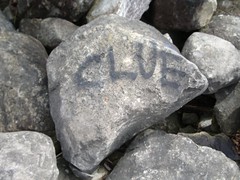I’ve been wanting to do this series for a while. As proof, when I saw this article on Story as Garden on Flogging the Quill five months ago, I saved it to use in this series.
In it, Ray Rhamey describes the foreshadowing we’ve mentioned here like “seeds.” He gives a few good examples: setting up a wedding ring that will later save the protagonist’s life, or the massive fist of someone who’ll deliver the knockout punch later (and yes, both of those are literal). Seeding these dramatic turns takes them from the territory of “over the top surprise,” making the reader feel cheated, to the realm of flawless, almost magical storytelling—and, he points out, can help make seeming Deus ex machina plot twists feel, pardon the pun, organic.
 This applies across all genres, he says: “A mystery writer must, of course, plant clues—interesting how even the language for doing this kind of thing is from gardening—but the rest of us need to pay attention to our seeding as well, for both action and characterization.”
This applies across all genres, he says: “A mystery writer must, of course, plant clues—interesting how even the language for doing this kind of thing is from gardening—but the rest of us need to pay attention to our seeding as well, for both action and characterization.”
But if you haven’t been leaving your clues all along, all is not lost! Ray points out that with computers, it’s really easy to go back and add little phrases, hints of backstory (or heck, even whole scenes and chapters) to build up to a new element you’ve decided to add. Here’s his example (emphasis mine):
About a third of the way into a novel, the female protagonist needs to be pulled out of a suicidal dive caused by the tragic death of her once-in-a-lifetime love. She encounters a small boy who seems to suffer from autism. She is a healer, and is sympathetic, but his condition and innocence didn’t seem like motive enough to stir her from her depression.
So what would? How about if the child reminded her in a specific, powerful way of the man she had loved and lost? So the author went back to the scene leading to her love’s death and gave him a “little-boy-lost” look that had always melted her heart. Then the narrative showed her seeing that same look in the eyes of the boy. That stimulus started her on the path of helping the child, which ultimately brought her back to emotional life. The phrase “little-boy-lost” was seeded in three places that added up to powerful motivation for her when the right time came. By the way, the seed had to be distinctive enough to be easily recalled when the time came; in this case, little-boy-lost not only fit unobtrusively the first time it was used, i.e., didn’t call attention to itself, it was distinct enough to remember later.
So seed your novel with small things early on that grow to be significant.
Check out the full article!
What do you think? Do you “seed” your clues as you go, or “post seed,” adding them in behind you once you’re further along?
Photo by Fras1977

 And let’s face it, these clues are a tough balancing act. We have to let the reader know there’s something coming for them, that these events that don’t seem significant will be—but at the same time, we can’t build small things up too much, or we’ll disappoint our readers instead of rewarding them with the payoff, and probably more importantly, we don’t want to give away the coming twists.
And let’s face it, these clues are a tough balancing act. We have to let the reader know there’s something coming for them, that these events that don’t seem significant will be—but at the same time, we can’t build small things up too much, or we’ll disappoint our readers instead of rewarding them with the payoff, and probably more importantly, we don’t want to give away the coming twists.